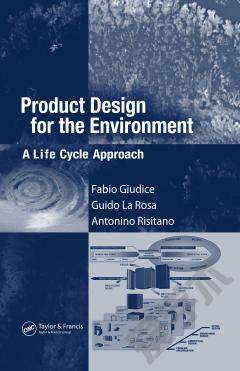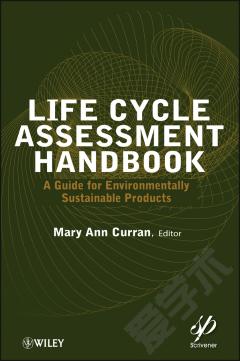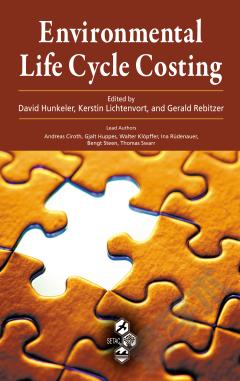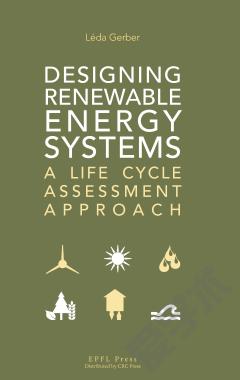Product Design for the Environment —— A Life Cycle Approach
----- 环保产品设计:使用寿命
FROM SUSTAINABLE DEVELOPMENT TO DESIGN FOR ENVIRONMENT Sustainable Development Industrial Ecology Design in the Context of the Environmental Question Design for Environment Concepts, Tools and Approaches to the Environmental Question: Overview Standards and Regulations Oriented Towards Environmental Quality of Products Summary References PART I - LIFE CYCLE APPROACH LIFE CYCLE APPROACH AND THE PRODUCT-SYSTEM CONCEPT AND MODELING Life Cycle Concept and Theory Life Cycle and the Product-System Concept Product-System and Environmental Impact Life Cycle Modeling Product Life Cycle: Reference Model Summary References LIFE CYCLE DESIGN AND MANAGEMENT Life Cycle Approach in Product Design Life Cycle Design Oriented toward Environmental Performance of Products Life Cycle Management Summary References LIFE CYCLE ASSESSMENT Environmental Analysis and Evaluation of the Life Cycle Premises, Properties and Framework of Life Cycle Assessment Fields of Application and Limitations of Life Cycle Assessment Overview of Practical Approaches and Tools for Life Cycle Assessment Summary References LIFE CYCLE COST ANALYSIS Cost Analysis and the Life Cycle Approach Product Life Cycle Cost Analysis Evolution of Models for Product Life Cycle Cost Analysis Reference Standards and Codes of Practice Summary References INTEGRATED ECONOMIC-ENVIRONMENTAL ANALYSIS OF THE LIFE CYCLE Life Cycle Cost Analysis and Environmental Aspects Environmental Costs and Environmental Accounting Integration Between LCCA and LCA Other Approaches to Economic-Environmental Analysis: Eco-Cost Models Summary References PART II - METHODOLOGICAL STATEMENT PRODUCT DESIGN AND DEVELOPMENT PROCESS Product Design and Development Product Design Methodological Evolution in Product Design Summary References INTEGRATION OF ENVIRONMENTAL ASPECTS IN PRODUCT DESIGN Orientation toward Environmental Aspects in the Design Process Environmental Strategies for the Life Cycle Approach Tools and Techniques for Environmental Requirements of the Life Cycle Integration in Product Development: Proposed Framework Toward an International Standard: The ISO/TR 14062 Technical Report Summary References LIFE CYCLE ENVIRONMENTAL STRATEGIES AND CONSIDERATIONS FOR PRODUCT DESIGN Strategies for Improving Resources Exploitation and Determinant Factors Strategies for Extension of Useful Life and Design Considerations Strategies for Recovery at End-of-Life and Design Considerations Product Modularity as a Key Concept for the Application of Environmental Strategies Summary References ENGINEERING METHODS FOR PRODUCT DURATION DESIGN AND EVALUATION Durability of Products and Components Fatigue of Materials Damage Thermography and the Risitano Method Summary References PART III - METHODS, TOOLS, AND CASE STUDIES PRODUCT CONSTRUCTIONAL SYSTEM DEFINITION BASED ON OPTIMAL LIFE CYCLE STRATEGIES Aims and Approach Method and Tools for Analysis and Design Optimal Life Cycle Strategy Evaluation Tool Case Study: System Analysis and Redesign of a Household Refrigerator Final Remarks Summary References ENVIRONMENTAL CHARACTERIZATION OF MATERIALS AND OPTIMAL CHOICE Materials Selection and Environmental Properties Environmental Characterization of Materials and Processes Summary of Selection Method Analysis of Production Feasibility Analysis of Performance Life Cycle Indicators Analysis of Results and Optimal Choice Case Study: Selection of Material for an Automobile Brake Disk Acknowledgements Summary References DESIGN FOR DISASSEMBLY AND DISTRIBUTION OF DISASSEMBLY DEPTH Design for Disassembly and Disassembly Level Distribution of Disassembly Depth Objectives and Approach to the Problem Method Statement Evaluation of Disassembly Depth Efficiency of Ease of Disassembly Distribution Case Study: Electromechanical System Summary References OPTIMAL DISASSEMBLY PLANNING Disassembly Planning Objectives and Approach to the Problem Common Structure of the Proposed Tools Development of the First Tool: Goals of Servicing Development of the Second Tool: Goals of Recovery Simulations and Analysis of Results Summary References PRODUCT RECOVERY CYCLES PLANNING AND COST-BENEFIT ANALYSIS OF RECOVERY Approach to the Recovery Problem Method for Recovery Cycles Planning Calculation Models for Recovery Cycles Planning Case Study: Analysis and Optimization of Heat Exchanger Constructional Systems Cost-Benefit Analysis of Recovery Cycles Acknowledgements Summary References METHODOLOGICAL FRAMEWORK AND ANALYSIS MODELS FOR SIMULATION OF PRODUCT LIFE CYCLE Simulation and the Life Cycle Approach Approach to the Problem and Methodological Framework Product Model and Analysis Tools Definition of Objective Functions Simulation and Analysis of Results Summary References
{{comment.content}}








 京公网安备 11010802027623号
京公网安备 11010802027623号